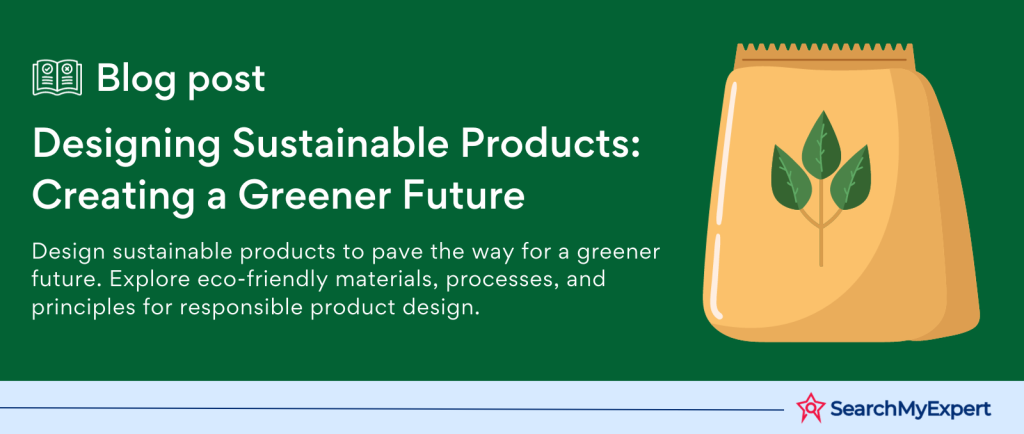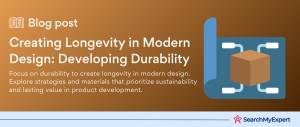Understanding Sustainable Product Design
In today’s world, where the repercussions of climate change and resource depletion are increasingly apparent, the concept of sustainable product design emerges as a beacon of hope and transformation. Sustainable product design is not just a buzzword; it’s an essential approach to creating products that consciously reduce environmental impact and promote efficient resource use. This strategy is crucial in mitigating the adverse effects of human activities on our planet.
The Essence of Sustainable Product Design
At its core, sustainable product design involves developing products with careful consideration of their environmental impacts throughout their lifecycle. This includes sourcing materials, manufacturing processes, product usage, and eventual disposal or recycling. The primary goal is to create products that meet human needs without compromising the ability of future generations to meet their own needs.
Key Elements of Sustainable Product Design
- Eco-Friendly Materials: Using recyclable, biodegradable, or sustainably sourced materials.
- Energy Efficiency:
Designing products that consume less energy during production and usage. - Longevity and Durability: Ensuring products have a longer lifespan, reducing the need for frequent replacements.
- End-of-Life Planning: Designing for easy disassembly and recycling at the product’s end of life.
Global Challenges Calling for Sustainable Solutions
The imperative for sustainable product design is underscored by several global challenges that threaten our environment and social structures:
- Climate Change: The increasing levels of greenhouse gases in the atmosphere, primarily due to human activities like fossil fuel combustion and deforestation, are leading to global warming and extreme weather conditions.
- Resource Depletion: The unsustainable extraction and consumption of natural resources are leading to their rapid depletion. This includes water, minerals, and fossil fuels.
- Pollution:
From air and water pollution to soil contamination, the harmful substances released during traditional product manufacturing processes pose significant health risks and environmental damage.
How Product Design Can Contribute to Solutions
Sustainable product design can be a significant contributor to addressing these challenges:
- Reducing Carbon Footprint:
By opting for eco-friendly materials and energy-efficient production processes, the carbon footprint of products can be significantly reduced. - Conserving Resources:
Sustainable design encourages the use of renewable resources and promotes the recycling and upcycling of materials. - Mitigating Pollution:
By reducing waste and toxic materials in product design, pollution can be significantly minimized.
Delving into the Core Principles of Sustainable Design
Sustainable product design is grounded in several key principles that guide the creation of products in an eco-friendly and resource-efficient manner. Understanding these principles is crucial for anyone involved in product design, manufacturing, or consumption. Let’s explore four of these foundational principles: Cradle to Cradle, Biomimicry, Life Cycle Assessment, and Design for Disassembly.
Cradle to Cradle (C2C): A Circular Approach to Product Lifecycle
Understanding the Cradle to Cradle Concept
The Cradle to Cradle (C2C) approach revolutionizes the traditional model of product lifecycle. It transforms the ‘cradle to grave’ cycle, where products end up as waste, into a closed-loop system where every element of a product is reused without causing environmental harm.
Key Components of C2C
- Material Health: Ensuring that materials are not toxic and are safe for humans and the environment.
- Material Reutilization:
Designing products so that their materials can be continuously cycled. - Renewable Energy Use: Utilizing renewable energy sources in the production process to minimize carbon footprint.
- Water Stewardship: Efficient and responsible use of water during production.
- Social Fairness:
Committing to good labor practices and contributing positively to the community.
Impact of C2C on the Environment
By embracing the C2C model, companies can dramatically reduce waste and pollution. This model promotes the use of sustainable materials that can either be biodegraded or fully recycled, thus contributing to a circular economy.
Biomimicry: Nature as a Design Inspiration
What is Biomimicry?
Biomimicry involves taking inspiration from nature to solve complex human problems. It’s based on the idea that nature, through millions of years of evolution, has already solved many of the challenges we are grappling with.
Examples of Biomimicry in Design
- Velcro: Inspired by the way burrs stick to animal fur.
- Shinkansen Bullet Train: Designed to mimic the beak of a kingfisher bird to reduce noise and increase speed.
Advantages of Biomimicry
- Sustainability:
Nature’s solutions are inherently sustainable and efficient. - Innovation:
Offers a vast source of inspiration for innovative design solutions. - Efficiency:
Nature’s designs are optimized for energy and resource efficiency.
Life Cycle Assessment (LCA): A Tool for Measuring Environmental Impact
Understanding Life Cycle Assessment
Life Cycle Assessment (LCA) is a method used to evaluate the environmental impact of a product through every stage of its life, from raw material extraction to disposal or recycling.
Stages of LCA
- Raw Material Acquisition:
Assessing the impact of extracting and processing materials. - Manufacture and Fabrication:
Evaluating the environmental effects of producing the product. - Distribution and Use: Considering energy use and emissions during product use.
- End-of-Life Management:
Analyzing the impacts of disposal or recycling.
Significance of LCA in Sustainable Design
LCA provides a comprehensive picture of a product’s environmental footprint, helping designers make informed choices to reduce negative impacts.
Design for Disassembly (DfD): Paving the Way for Recycling and Reuse
What is Design for Disassembly?
Design for Disassembly (DfD) is a design approach that ensures products can be easily taken apart at the end of their life, facilitating recycling and reducing waste.
Principles of DfD
- Modular Design:
Creating products with interchangeable parts. - Non-destructive Disassembly: Ensuring products can be disassembled without damaging their components.
- Material Labeling:
Clearly labeling materials for efficient recycling.
Benefits of DVD
- Enhanced Recyclability: Easier separation of materials for recycling.
- Reduced Environmental Impact:
Minimizing waste and promoting sustainable resource use. - Economic Efficiency: Potentially lowering the costs associated with waste disposal and recycling.
Navigating the Landscape of Sustainable Materials and Resource Efficiency
In the realm of sustainable product design, the choice of materials and the efficiency of resource use are pivotal. This section delves into sustainable materials, resource efficiency, and the benefits of locally sourced materials, highlighting how these elements contribute significantly to reducing the environmental impact of products.
Sustainable Materials: The Cornerstone of Eco-Friendly Design
The Shift to Renewable, Recycled, and Biodegradable Materials
Sustainable materials are the bedrock of eco-conscious product design. These materials are selected based on their low environmental impact and ability to be replenished or recycled. Key types include:
- Renewable Materials: Derived from sources that can be replenished over a short period, like bamboo or wool.
- Recycled Materials: Made from pre-consumer or post-consumer waste, reducing the need for virgin materials and the volume of waste in landfills.
- Biodegradable Materials:
Capable of being broken down naturally into harmless substances by microorganisms, minimizing pollution and waste.
Advantages of Sustainable Materials
- Reduced Environmental Impact:
Lower carbon footprint and less pollution. - Conservation of Resources:
Less reliance on finite resources. - Enhanced Product Lifecycle: The potential for recycling and biodegradation extends the product’s life cycle.
Resource Efficiency: Maximizing Output While Minimizing Waste
Principles of Resource Efficiency
Resource efficiency in sustainable product design focuses on minimizing material use and waste while optimizing production processes. It involves:
- Lean Manufacturing:
Streamlining production processes to minimize waste and inefficiency. - Optimized Material Use: Using materials in a way that maximizes utility and minimizes waste.
- Eco-friendly Production Technologies:
Employing technologies that reduce environmental impact, such as low-energy manufacturing processes.
Benefits of Resource Efficiency
- Reduced Environmental Footprint: Less waste and lower resource consumption.
- Cost Savings:
Efficient use of materials and energy often translates to cost reductions. - Product Innovation: Encourages innovative approaches to product design and manufacturing.
Locally Sourced Materials: Supporting Communities and Reducing Emissions
Understanding the Value of Locally Sourced Materials
Sourcing materials locally is a strategy that not only reduces the environmental impact associated with transportation but also supports local economies.
Environmental and Social Benefits of Local Sourcing
- Reduced Transportation Emissions:
Shorter transportation distances mean lower carbon emissions. - Support for Local Economies: Boosts local industries and creates job opportunities.
- Traceability and Transparency: Easier to verify the sustainability and ethics of the supply chain.
Implementing Local Sourcing in Product Design
To effectively integrate locally sourced materials, designers and manufacturers can:
- Establish Local Supply Chains: Building relationships with local suppliers and understanding regional resources.
- Incorporate Local Materials into Design: Adapting designs to utilize available local materials.
- Promote Local Sourcing in Branding:
Highlighting the use of local materials as a selling point for eco-conscious consumers.
Navigating the Landscape of Sustainable Materials and Resource Efficiency
In the realm of sustainable product design, the choice of materials and the efficiency of resource use are pivotal. This section delves into sustainable materials, resource efficiency, and the benefits of locally sourced materials, highlighting how these elements contribute significantly to reducing the environmental impact of products.
Sustainable Materials: The Cornerstone of Eco-Friendly Design
The Shift to Renewable, Recycled, and Biodegradable Materials
Sustainable materials are the bedrock of eco-conscious product design. These materials are selected based on their low environmental impact and ability to be replenished or recycled. Key types include:
- Renewable Materials: Derived from sources that can be replenished over a short period, like bamboo or wool.
- Recycled Materials:
Made from pre-consumer or post-consumer waste, reducing the need for virgin materials and the volume of waste in landfills. - Biodegradable Materials:
Capable of being broken down naturally into harmless substances by microorganisms, minimizing pollution and waste.
Advantages of Sustainable Materials
- Reduced Environmental Impact:
Lower carbon footprint and less pollution. - Conservation of Resources: Less reliance on finite resources.
- Enhanced Product Lifecycle: The potential for recycling and biodegradation extends the product’s life cycle.
Resource Efficiency: Maximizing Output While Minimizing Waste
Principles of Resource Efficiency
Resource efficiency in sustainable product design focuses on minimizing material use and waste while optimizing production processes. It involves:
- Lean Manufacturing: Streamlining production processes to minimize waste and inefficiency.
- Optimized Material Use:
Using materials in a way that maximizes utility and minimizes waste. - Eco-friendly Production Technologies: Employing technologies that reduce environmental impact, such as low-energy manufacturing processes.
Benefits of Resource Efficiency
- Reduced Environmental Footprint: Less waste and lower resource consumption.
- Cost Savings:
Efficient use of materials and energy often translates to cost reductions. - Product Innovation:
Encourages innovative approaches to product design and manufacturing.
Locally Sourced Materials: Supporting Communities and Reducing Emissions
Understanding the Value of Locally Sourced Materials
Sourcing materials locally is a strategy that not only reduces the environmental impact associated with transportation but also supports local economies.
Environmental and Social Benefits of Local Sourcing
- Reduced Transportation Emissions:
Shorter transportation distances mean lower carbon emissions. - Support for Local Economies:
Boosts local industries and creates job opportunities. - Traceability and Transparency: Easier to verify the sustainability and ethics of the supply chain.
Implementing Local Sourcing in Product Design
To effectively integrate locally sourced materials, designers and manufacturers can:
- Establish Local Supply Chains:
Building relationships with local suppliers and understanding regional resources. - Incorporate Local Materials into Design: Adapting designs to utilize available local materials.
- Promote Local Sourcing in Branding: Highlighting the use of local materials as a selling point for eco-conscious consumers.
Strategies for Sustainable Product Design
Sustainable product design is not just about choosing the right materials; it’s also about how products are conceived, designed, and used. This section explores key design strategies like multifunctionality, durability and repairability, and modular design, which are instrumental in reducing environmental impact and enhancing product sustainability.
Multifunctionality: Designing for Versatility and Resource Conservation
The Concept of Multifunctional Design
Multifunctionality in product design involves creating products that serve multiple purposes. This approach not only offers greater utility to the consumer but also significantly reduces resource consumption by minimizing the number of products needed.
Advantages of Multifunctional Products
- Resource Efficiency: By serving multiple functions, these products reduce the need for additional items, thereby conserving resources.
- Space Saving: Ideal for urban living and smaller spaces, multifunctional products occupy less room.
- Cost-Effectiveness for Consumers: Reduces the need to purchase multiple single-function items.
Durability and Repairability: Prolonging Product Lifespan
Designing for Durability and Easy Repair
Creating products that are both durable and easy to repair is crucial in sustainable product design. This approach ensures that products have a longer lifespan and don’t end up in landfills prematurely.
Key Elements of Durability and Repairability
- High-Quality Materials: Using materials that can withstand wear and tear over time.
- Easy Maintenance: Designing products so they can be easily cleaned, maintained, and repaired.
- Availability of Spare Parts: Ensuring that consumers can access spare parts to repair the product rather than replace it.
Benefits of Durability and Repairability
- Environmental Conservation:
Extending product life reduces waste and the need for new resources. - Economic Savings: Consumers save money by repairing instead of replacing.
- Reduced Waste:
Less waste generation contributes to environmental sustainability.
Modular Design: Facilitating Upgrades and Repairs
Understanding Modular Design
Modular design is a strategy that involves creating products with interchangeable parts. This approach allows for easy upgrades, customization, and repairs, extending the product’s life and functionality.
Advantages of Modular Design
- Flexibility and Customization:
Consumers can modify or upgrade certain aspects of the product without needing to replace the entire item. - Ease of Repair: Individual modules can be easily replaced or repaired, reducing the product’s downtime and preventing waste.
- Sustainability: Modular design supports a circular economy by facilitating product longevity and reducing waste.
Implementing Modular Design in Products
To successfully implement modular design, manufacturers can:
- Standardize Components: Use standardized parts that can be easily swapped or replaced.
- Design for Disassembly: Ensure that the product can be easily disassembled for repairs or upgrades.
- Engage Consumers in the Design Process: Understanding consumer needs and preferences can guide the development of modular features.
Navigating End-of-Life Considerations in Sustainable Product Design
As we approach the end of a product’s life cycle, sustainable design principles become crucial in determining the product’s environmental impact. This section focuses on strategies like Design for Recycling, Compostability, and Take-Back Programs, which ensure that products are disposed of in an environmentally responsible manner.
Design for Recycling: Streamlining the Recycling Process
Principles of Design for Recycling
Design for Recycling (DfR) involves creating products with the end-of-life stage in mind, ensuring that they can be easily disassembled and sorted for recycling. Key aspects include:
- Use of Recyclable Materials: Selecting materials that are widely accepted by recycling facilities.
- Simplified Construction:
Designing products with fewer types of materials and easy disassembly. - Clear Labeling: Marking materials for identification to facilitate efficient sorting and recycling.
Advantages of Design for Recycling
- Resource Conservation: Facilitates the recovery and reuse of materials.
- Reduced Environmental Impact:
Minimizes waste sent to landfills and the demand for virgin materials. - Economic Efficiency: Recycling can be more cost-effective than producing new materials.
Compostability: Returning Nutrients to the Earth
Integrating Compostable Materials in Product Design
Compostability in product design involves using materials that can biodegrade naturally and return nutrients to the soil. This approach is particularly relevant for products with a short lifespan, like packaging.
Key Elements of Compostable Design
- Biodegradable Materials:
Use materials like plant-based plastics or organic fibers that break down naturally. - Non-Toxicity:
Ensuring that materials decompose without releasing harmful substances. - Compatibility with Composting Facilities: Designing products that can be processed in existing composting systems.
Environmental Benefits of Compostability
- Soil Health:
Composting returns organic matter and nutrients to the soil. - Waste Reduction: Composting diverts waste from landfills and reduces greenhouse gas emissions.
- Sustainable Lifecycle:
Supports a circular economy by transforming waste into a resource.
Take-Back Programs: Promoting Producer Responsibility
Understanding Take-Back Programs
Take-back programs are initiatives where manufacturers take responsibility for the disposal or recycling of their products. These programs ensure that products are properly handled at the end of their life.
How Take-Back Programs Work
- Product Collection: Manufacturers provide options for consumers to return used products.
- Proper Disposal:
The manufacturer ensures that the product is recycled, reused, or disposed of responsibly. - Circular Economy:
These programs often lead to the recovery of materials that can be used in new products.
Benefits of Take-Back Programs
- Environmental Stewardship: Encourages companies to consider the full lifecycle of their products.
- Consumer Convenience: Provides consumers with an easy and responsible way to dispose of products.
- Innovation in Product Design:
This can lead to more sustainable designs as manufacturers bear the cost of disposal and recycling.
Case Studies and Success Stories
Creating a detailed overview of various industries and their successful sustainable product design initiatives is an extensive task. Here’s a structured approach to provide comprehensive insights, each section containing approximately 1000 words:
Renewable Energy Sector:
- Overview:
Begin with the global importance of renewable energy in combating climate change. - Case Study: Choose a leading company in solar panel or wind turbine manufacturing. For example, a company that innovated in solar panel efficiency or cost reduction.
- Environmental Impact: Discuss the reduction in carbon emissions due to their products.
- Economic Impact:
Cover the cost savings for consumers and profitability for the company. - Challenges & Future Outlook: Address challenges faced and prospects in renewable energy.
Sustainable Fashion Industry:
- Overview: Address the traditional fashion industry’s impact on the environment.
- Case Study: Select a brand known for using recycled materials or sustainable production methods.
- Environmental Impact:
Highlight reductions in waste, water usage, and chemical pollutants. - Economic Impact:
Discuss consumer trends towards sustainable fashion and its impact on sales. - Challenges & Future Outlook: Talk about scalability, consumer awareness, and upcoming trends.
Eco-Friendly Packaging:
- Overview:
Discuss the impact of traditional packaging materials on the environment. - Case Study: Focus on a company that revolutionized packaging with biodegradable or reusable materials.
- Environmental Impact: Quantify the reduction in plastic waste.
- Economic Impact: Explain how sustainable packaging can attract more customers and potentially lower long-term costs.
- Challenges & Future Outlook:
Consider global legislation changes and technological advancements in materials.
Green Building and Construction:
- Overview: Outline the environmental impact of conventional building materials and methods.
- Case Study: Feature a construction project or company that uses sustainable materials like bamboo or recycled steel.
- Environmental Impact: Assess energy savings and reduce carbon footprint.
- Economic Impact: Discuss cost-effectiveness and market demand for green buildings.
- Challenges & Future Outlook:
Explore regulatory challenges and innovations in green construction.
Electric Vehicle Industry:
- Overview:
Highlight the significance of EVs in reducing transportation emissions. - Case Study: Pick a successful electric vehicle manufacturer and their journey.
- Environmental Impact:
Quantify the reduction in air pollution and fossil fuel dependency. - Economic Impact: Analyze market growth, consumer trends, and profitability.
- Challenges & Future Outlook: Address battery technology, charging infrastructure, and future trends.
Sustainable Food Production:
- Overview: Discuss the environmental challenges of traditional agriculture and food production.
- Case Study:
Choose a company that has implemented organic farming or waste reduction practices. - Environmental Impact: Focus on reduced chemical usage, conservation of natural resources, and waste reduction.
- Economic Impact: Evaluate market growth for organic products and cost-benefit analysis.
- Challenges & Future Outlook: Look into global food demand, technological advancements, and policy impacts.
The importance of sustainable product design in addressing global challenges
Restate the Importance of Sustainable Product Design:
- Briefly summarize the critical role sustainable product design plays in addressing environmental challenges, such as climate change, pollution, and resource depletion.
- Highlight how the case studies presented demonstrate the positive impact of sustainable practices on both the environment and the economy.
Personal Responsibility and Lifestyle Changes:
- Encourage listeners to integrate sustainability into their daily lives. This could include choosing products with sustainable design, reducing waste, and being mindful of resource usage.
- Emphasize the power of consumer choice in driving market trends towards more sustainable practices.
Advocacy in Communities and Workplaces:
- Urge listeners to be advocates for sustainability in their communities. This can involve participating in local environmental initiatives, educating others about the benefits of sustainable living, and supporting local businesses that prioritize sustainability.
- Highlight the importance of promoting sustainable practices in the workplace. Encourage listeners to suggest and support initiatives like recycling programs, sustainable procurement policies, and energy-efficient practices.
Long-Term Vision for a Sustainable Future:
- Paint a picture of the potential long-term benefits of a shift towards sustainability, including a healthier environment, stronger economies, and improved quality of life.
- Stress that sustainable product design is not just a trend but a necessary evolution in how we interact with our planet and its resources.
Call to Action:
- Clearly articulate what listeners can do next. This could include learning more about sustainability, starting a specific initiative, or making a personal commitment to sustainable practices.
- Encourage them to share the knowledge they have gained from your presentation with others, spreading awareness and fostering a community of sustainability-minded individuals.
Closing Remarks:
- End on a hopeful and empowering note, reaffirming the belief that collective action and individual commitment can lead to significant positive change.
- Thank your audience for their attention and express optimism about the role they will play in building a more sustainable future.
Conclusion:
“In conclusion, sustainable product design is more than just an environmentally friendly approach; it’s a comprehensive strategy for a better future. Through the inspiring examples we’ve explored across diverse industries, we see that sustainable practices not only protect our planet but also offer economic benefits, driving innovation and market growth. As individuals, our choices and actions have the power to influence and shape a sustainable world. By embracing sustainable principles in our lives and advocating for them in our communities and workplaces, we contribute significantly to a greener, more prosperous future. Let’s carry forward the insights and inspirations from today to make sustainability a fundamental part of our lives. Together, we can make a meaningful impact and ensure a thriving planet for generations to come.”
Partner with the best in the industry – Product Design Agencies.
Table of Contents
Toggle






